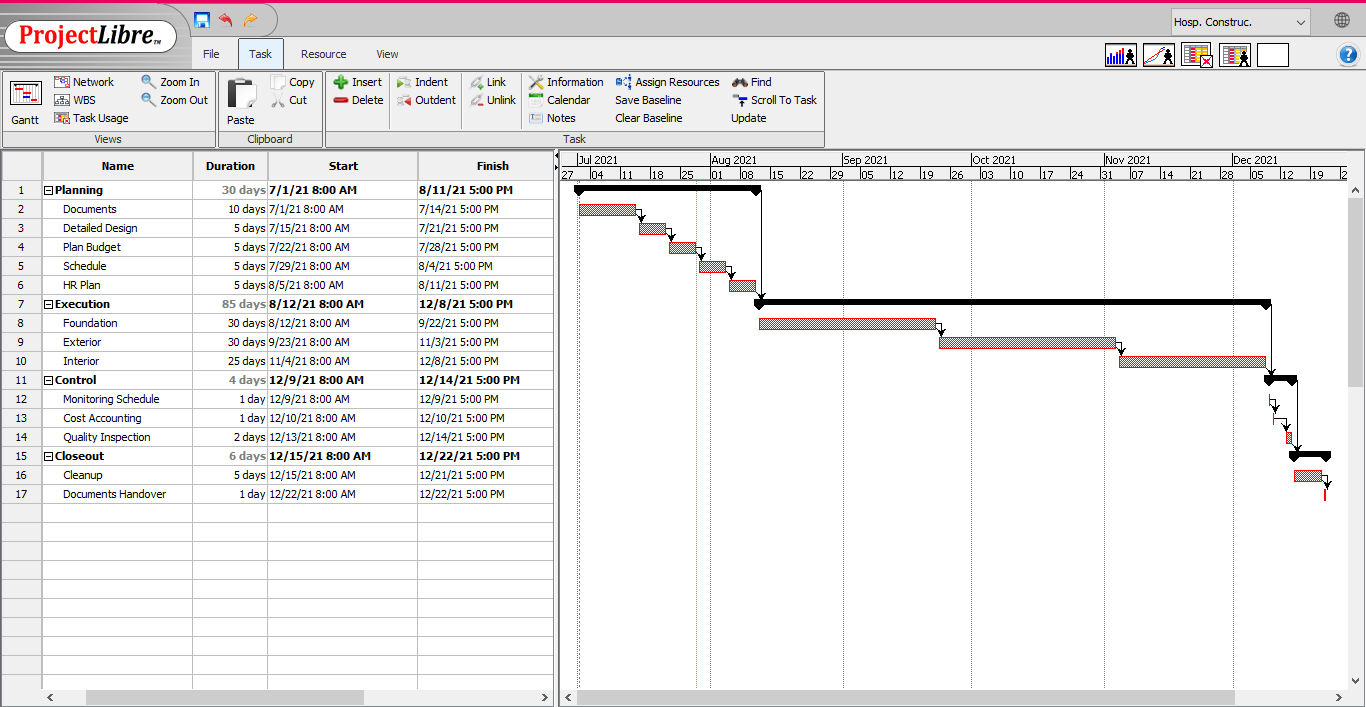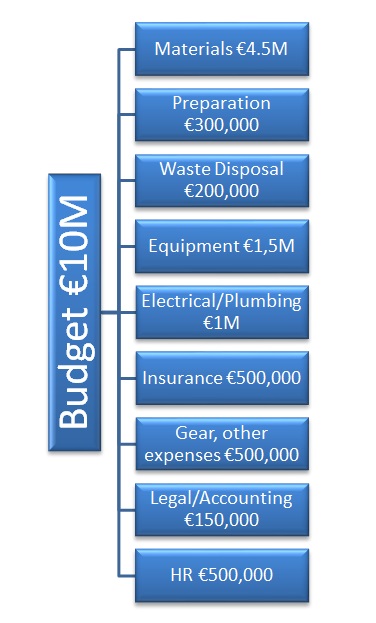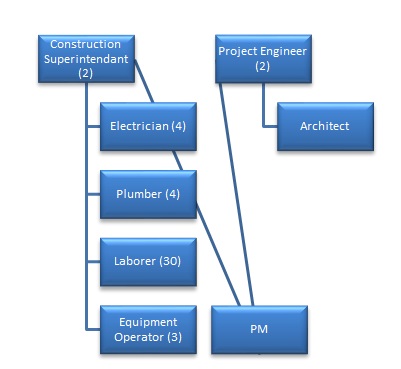Introduction
Kiros Slonis SA, a construction company specializing in construction projects in the medical industry, landed a contract to build a small hospital. The general guidelines suggest the hospital will have 100 rooms, and it will accommodate Covid-19 patients. The location is a government-owned plot in a residential area in the suburbs. The project must be completed by December 21st, 2021, which means the duration is six months (26 weeks). The timescale cannot be altered because of the urgency of the situation and the negotiations with the governmental authorities (local and central) that are agreed upon in the signed contract and the RFP. The allocated budget for this project is 10M euros.
Scope
The report will include every step that will benefit the overall scope, which involves listing the goals, tasks, expenses, and timelines. This consists of the timescale of the project, all the steps that will lead to its finalization, methods and tools used to scrutinize every action, an assessment of possible risks, etc. Organizing the scope in an efficient manner influences the working process and the finalization itself, which highlights the importance and benefit of creating an exact structure of the future progress. The report will leave out redundant details that do not have a significant influence on the productivity of the project and the final result.
Topics of The Report
Certain tasks will be discussed, and the order they are presented will suggest the specific schedule of the entire project. Construction projects are complex and high-risk because of the many aspects they depend on in order for the tasks to be successfully finalized (Okudan et al., 2021). This is why it is crucial to scrutinize all the details that will contribute to a smooth workflow. The steps are divided into main categories: planning, execution, control, and closeout. Planning is the first primary task divided into subtasks such as documents, detailed design, budget plan, schedule, and HR plan. Each of the steps is important in preparing the project for execution. According to Ika et al., project management is related to the concern of organization and change delivery (2020). This is why having a detailed plan is essential for the workflow.
Everything needs to be organized, from the list of employees who are going to work on the building to the schedule that needs to be followed during the process to start the construction. The second major step is the execution, which is divided into the foundation, exterior, and interior. This is the lengthiest task that requires enough human resources for it to be finalized in time. After execution, control of the progress is necessary. This will include monitoring the schedule, cost accounting, and quality inspection, which will refer to contract compliance. Last but not least, the closeout phase will consist of cleanup and documents handover.
For planning, scheduling, and presenting specific data, Project Libre will be used. By creating charts (Gantt, WBS), the critical path analysis will describe every step of the project, how tasks interfere, and how much time is required for each primary task and subtask to be successfully finalized. The critical path method is indispensable for monitoring the progress (Petroutsatou, 2019). Such analysis was used when creating a budget plan, an HR plan, and the whole rundown of the project with specific steps that interfere with each other. By using this method, the risk factors decrease, and the flow of the construction is much more structured and organized.
The waterfall method was used while creating the schedule. According to researchers, PM methodologies are beneficial for reducing expenses and increasing the success rate (Abdulla et al., 2019). The tasks and subtasks are sequential, which means that the progress is focused in one direction only. This methodology is applicable for the construction project because the final goal is identifiable, the process is somewhat predictable, and the construction industry is highly regulated. This is why every step is highly dependant on the previous one, which makes the waterfall methodology advantageous.
Project Summary
The construction project will include building a 100-room hospital on government-owned land in a suburban area that will accommodate Covid-19 patients. The deadline is December 31st, and the project can not be delayed because of the severity of the cause and urgency. At first, it is important to point out the main tasks and subtasks that will structure the project into steps that ought to be followed based on the order. The software used to plan the project is Project Libre, which will be helpful at organizing and scheduling every step till project finalization. The Project Libre Gannt diagram helps identify the time span of each subtask and task, which is beneficial for scheduling and having an exact timeframe that must be followed in order for the deadline not to be exceeded. The primary structural needs contain the Project span, HR plan, and budget distribution. Structuring these aspects into multiple subtasks offers a broader understanding of critical factors and aspects that will make the process of working on the project more detailed.
Stakeholders
Identifying the stakeholders is the first step in project planning. According to Verga Matos et al., project management is highly dependent on the diversity of the stakeholders (2019). They attend the meeting and have an influence on how the process starts, evolves, and finishes. The stakeholders are individuals, groups, or organizations that are influenced by the project in one way or the other. The influence may be economic, social, physical, etc. This project’s stakeholders are the government, the project manager, executives, users, suppliers of materials, and others. Every person, company, and institution that is influenced by the flow of the project is a stakeholder.
Critical Path Analysis
It is essential to focus on specific tools that will facilitate the process of finalizing the project before scrutinizing every step and task. Critical path analysis has been used, which is a technique that involves organizing the process into tasks. These tasks help identify the key points, the time required for each step, and the interdependencies between them. The Gantt chart is useful for structuring the time and creating connections between tasks and subtasks. It has also been suggested that it is beneficial for monitoring and forecasting (Lee & Shvetsova, 2019). The WBS chart helps portray the budget for every section.

Project management is linked to the creation of a planned scheme that would address aspects of the work process. PM is often solely portrayed by organizational structure (Radujković & Sjekavica, 2017). This suggests the advantages of structuring and planning ahead add clarity to the project. As mentioned above, the main tasks are divided into planning, execution, control, and closeout (Figure 1). Planning contains documents (preparing all the documents and contracts regarding the construction), detailed design (a detailed design of the future building), a budget plan (planning all the expenses), schedule (estimating the program for every step of the construction), and HR plan (analyzing the needed human resources and signing contracts with the employees).
The second primary task is the execution, which includes the foundation (deforesting the area and creating the foundation for the building), the exterior (the exterior walls), and the interior (interior work, electrical and plumbing activities). The control task is divided into monitoring the schedule (analyzing the work done and if it was finalized based on the initial schedule), cost accounting (checking if the budget plan was accurate and correlates with actual expenses), and quality inspection (checking if the building is similar to the aspects mentioned in the initial contract). The last phase is the handout, which includes cleanup (getting the facility fully ready) and document handout (presenting the actual budget, design, and HR plan to the employer who initiated the project).
Based on the Gantt chart, the planning phase will last 30 days, the construction – 85 days, the control – 4 days, and the closeup – 6 days. According to the plan, the project will be finalized before the deadline, which is December 31st. The estimated finalization will be on December 22nd, which leaves nine days for unexpected things which fall into the risk category. Leaving extra time before the required deadline is vital in case additional activities and tasks will occur during any phase.
Budget Plan

The initial budget for this project is €10M. All the expenses have to be included in the total budget and should not exceed it, which means structuring it into smaller points is important to plan the possible spendings ahead. Based on Figure 2, the budget is divided into materials, preparation, waste disposal, equipment, electrical/plumbing work, insurance, gear and additional expenses, and legal and accounting outsourcing. After calculating the final budget by adding all the scheduled costs, the estimated spending is €9,15M. This leaves extra resources for risk planning. The remaining €850,000 will be used in case one or multiple employees fail to deliver the expected results, an accident happens during the construction, or another circumstance requires urgent investments.
By breaking the budget down into two sections (Task and Activity), it is easy to obtain a correlation of which action is connected to a certain task. It also allows for a more in-depth analysis of the most costly or affordable tasks. For preparation, the logical activities will be deforestation, legal/accounting outsourcing, and organizing insurance. For construction, the activities contain HR (hiring the workforce), buying materials and equipment, plumbing and electrical work, and purchasing gear. The final task is the handout, and it includes waste disposal after the process is finalized.
HR Plan

Constructing and implementing the HR plan into the project’s process is a crucial step that influences the results. By hiring great specialists, planning the number of people required to finish the project before the deadline, and distributing tasks, the project becomes a collective effort. For the construction, two prominent positions are construction superintendent and project engineer. The engineer and the architect play significant roles in creating an efficient design that would satisfy the employer and the future users. The construction superintendents, on the other hand, supervise every step of the construction. The staff they manage consists of electricians, plumbers, laborers, and equipment operators.
Potential Risks
Identifying potential risks is an essential step in any project, and it is even more crucial in construction. It has been suggested that in complex projects, the ricks are usually interdependent (Islam et al., 2017). Certain risk factors may delay the project, cause more expenses, correlate with legal problems, or even lead to shortages of materials or labor. According to researchers, working with unidentified risks may create difficulties regarding the final budget becoming more substantial than the initial one (Kwon & Kang, 2018). When it comes to construction risks, safety hazards are the first aspects to be analyzed. Workers may be harmed or injured during the work process, highlighting the importance of safety training and specialized gear. Another potential risk includes unexpected increases in certain costs, such as the price for the materials. This is why planning the budget with a consideration of risk factors is essential. This will ensure safe and timely finalization despite external factors that may influence the process. Another risk is the damage of equipment or loss of materials and tools. This is an aspect that can be easily fixed with proper insurance, which is included in the budget scheme.
In case the employer is interested in making certain changes, the contract which was initially signed portrays an agreement that can be altered only if both the employer and the employee agree. If such changes are to be implemented, another budget and deadline should be required due to the preliminary agreement. A risk that is difficult to plan or overcome is the potential for natural disasters. The building is more fragile during the construction phase, and natural disasters can occur and create difficulties. The budget planned for unexpected expenses can diminish the impact. Last but not least, poor project management can be a significant cause of delays and improper scheduling and planning. This is why it is crucial to analyze and suggest solutions regarding every step of the project. Dividing big tasks into smaller goals is vital when it comes to creating a probable plan for the whole process.
Conclusion
The report for constructing a 100-room hospital with the deadline on December 31st, 2021, requires organizational management, which is portrayed through the critical analysis method. The stakeholders (Kiros Slonis SA, the government, the project manager, employees, users, etc.) will be influenced by the project itself, which means every step of the management process has to be mentioned, scrutinized, and precise. Gantt and WBS charts were used to structure every aspect of the budget, construction, and HR plan.
The report is divided into main topics such as the summary of the project, the stakeholders, critical path analysis, budget, HR plan, and potential risks. The summary of the project presents key agreements between Kiros Slonis SA and the employer, which requested a hospital that would be able to accommodate Covid patients. The duration agreed upon is six months, and the final phase shall not be delayed due to the urgency of the situation and the mutual agreements mentioned in the initial contract. The hospital shall have 100 rooms, and the location is discussed with the employer (the suburbs).
The stakeholders, as mentioned before, are individuals and organizations that will be influenced by the project on one level or another. The project manager and the staff benefit from a successful handout since it correlates with material gains, good reputation, and reliability on the market. The contractor, on the other hand, benefits by providing the public with good medical care in a comfortable location. The users are influenced by the project by their satisfaction level while staying at the hospital.
The budget and HR plan have been presented through WBS charts. The initial budget is 10M, and by organizing the exact spending, the project’s cost will be slightly lower. However, the extra money will be used for risk factors, which may occur during the construction phase. The HR plan suggests the need for at least 47 employees (including the PM) for a successful work flow that would fit into the time period mentioned initially. The WBS chart (Figure 3) refers to every single specialist that will contribute to the process.
Possible risks are also analyzed and minimized through certain aspects. Since the actual budget is slightly lower than all the costs calculated through the Gantt chart, the extra money can be spent on reducing risk factors. These include accidents and injuries at work, an increase in the cost of materials, poor management, and natural calamities. Each risk factor except the last one has the potential to be diminished. Injuries can be prevented by having safety training and adequate protective gear, an increase of certain costs can be included in the budget, poor management is fixed with the critical analysis, and damage from natural calamities can also be managed by using the extra resources remaining from the initial budget.
Project Libre is a tool that is helpful for project managers to have advanced schemes of the work process, which is why it has been used for this report. The Gantt charts are implemented for the HR and budget plant, which shows every employee and expense that will be required for the project to be successfully finalized. This is related to the critical path analysis, which is a methodology that is used for organizing the workflow and dividing tasks and positions into subtasks that are interconnected. The links are portrayed in the Gantt chart, while the expenses and HR positions are referred to in the WBS charts.
The project constraints are implemented by the contractor and evaluated through the project management process. The main limitations are the deadline, constrained budget, and the risks that are usually associated with construction. The deadline is set (December 31st, 2021), and the contractor was clear that delays are not acceptable. However, by constructing an efficient schedule, it has been suggested that the finalization will be on December 22nd, which leaves a couple of extra days for additional changes if required. The budget is also set, and it is 10M. By creating a WBS chart that features every possible expense, the actual budget exceeds the cost calculation. It is an efficient feature that leaves extra resources in case of certain potential risks. The risk factors have also been discussed and minimized through project organization and efficient management.
Reference List
Abdulla H, Alhashimi M and Hamdan AM (2019) ‘The impact of project management methodologies on project success’ Handbook of Research on Implementing Knowledge Management Strategy in the Public Sector: 418–437.
Ika LA, Söderlund J, Munro LT, et al. (2020) ‘Cross-learning between project management and international development: Analysis and research agenda’ International Journal of Project Management 38(8): 548–558. Web.
Islam MS, Nepal MP, Skitmore M, et al. (2017) ‘Current research trends and application areas of fuzzy and hybrid methods to the risk assessment of construction projects’ Advanced Engineering Informatics 33: 112–131. Web.
Kwon H and Kang CW (2018) ‘Improving project budget estimation accuracy and precision by analyzing reserves for both identified and unidentified risks’ Project Management Journal 50(1): 86–100. Web.
Lee S and Shvetsova OA (2019) ‘Optimization of the technology transfer process using Gantt charts and critical path analysis flow diagrams: Case study of the Korean automobile industry’ Processes 7(12): 1–27. Web.
Okudan O, Budayan C and Dikmen I (2021) ‘A knowledge-based risk management tool for construction projects using case-based reasoning’ Expert Systems with Applications, 173. Web.
Petroutsatou K (2019) ‘A proposal of project management practices in public institutions through a comparative analyses of critical path method and critical chain’ International Journal of Construction Management, 1–10. Web.
Radujković M and Sjekavica M (2017) ‘Project management success factors’ Procedia Engineering, 196: 607–615. Web.
Verga Matos P, Romão M, Miranda Sarmento J, et al. (2019) ‘The adoption of project management methodologies and tools by NGDOs: A mixed methods perspective’ Journal of Business Research, 101: 651–659. Web.